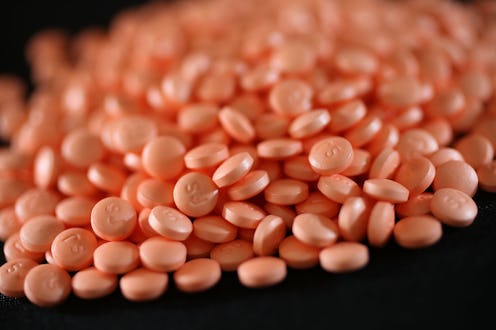News
We Need To Talk About This Kind Of Abuse
The prevalence of addictions to painkillers among American women isn't an entirely new phenomenon, but despite the rapid rate at which it continues to worsen, it isn't garnering all that much attention. Women are the fastest growing demographic for substance addiction, with most misusing medicines given to them by a doctor — up to 4.5 million women in the United States have a substance disorder, according to the National Council on Alcoholism and Drug Dependence (NCADD), with 3.5 million misusing prescription drugs. This country needs to be talking about prescription drug abuse, because opioid use disorder — the abuse of painkillers or heroin — is a major women's health issue that could drastically be improved by simply raising awareness.
About 18 women die every single day in the United States from opioid overdoses — a 400 percent increase since 1999, compared to a 265 percent increase in men. The huge gender gap in opioid use boils down to the differences in how women deal with physical pain and doctors. Women are more likely to experience chronic pain than men (or at least report it to a doctor) and are therefore prescribed more painkillers, which they also become addicted to much more quickly. "It's more socially acceptable that women will go to doctors to get medication to help with physical pain," says Dr. Marc Romano, assistant medical director at Ocean Breeze Recovery in Florida, explaining that men are more likely to turn to illicit drugs or alcohol.
Because of this, women are also far more likely to "doctor shop" (i.e. get prescriptions from multiple doctors), which allows them to fuel their addiction with legally obtained pills. You may be asking yourself how this is possible, and the answer is simple — in places that don't have a prescription registry, primary doctors, surgeons, and dentists don't know how many other prescriptions their patients already have.
Although it's extremely dangerous to take so many opioids, it can feel less harmful than taking illicit drugs like heroin. "If you’ve got a legal prescription from a doctor, you don’t feel like you’re doing anything that’s going to hurt you," says Dr. Julie Dostal, executive director at New York's LEAF Council on Alcoholism and Addiction.
Just like any disease, opioid abuse disorder requires professional medical help and it too frequently goes untreated. Dr. Romano tells Bustle:
It's one of those habits that can be hidden for a long period of time without anyone noticing it.
Women often face more extreme obstacles in seeking help because they're pregnant or have kids. Although it's widely recognized as a disease today, the stigma that drug addiction is a moral failure persists, and mothers can feel that shame more acutely than men. "Women who have children — who have families — they have a lot more guilt," Dr. Romano says. "There’s a lot more shame that they’ve let down their families."
On top of grappling with internal demons, there can be legal ramifications to seeking help as well. Currently, 18 states legally consider drug addiction while pregnant child abuse and Tennessee specifically criminalized drug use during pregnancy in 2014. "They essentially make it a crime for women with this disease to get pregnant, give birth, be a parent, and seek treatment," says Shruti Kulkarni, a Center for Lawful Access and Abuse Deterrence (CLAAD) policy adviser. "This further adds to the stigma of this disease and prevents women from seeking treatment."
Starting public discussions and raising awareness about opioid abuse among women would not only help patients know how to prevent themselves from becoming addicted to painkillers, but would also make treatment more accessible and less stigmatizing. It's not as simple as just telling women not to take painkillers, especially when they're in extreme pain or are already addicted. "It’s well established by science and medicine that opioid use disorder is a chronic relapsing disease of the brain," Kulkarni says. Women with opioid use disorder need to hear and understand that they haven't failed because they became addicted.
Dr. Dostal also believes that Americans need to readjust how they think about pain. As disheartening as it may sound, not everyone can be completely pain-free all the time, and using pills to mask physical discomfort only creates an additional problem.
"It's important that we keep talking about [opioid abuse] because we have a whole generation of people who have now grown up believing that zero on the pain scale is the goal, and it really just shouldn’t be the goal," she tells Bustle. "The goal is improvement of symptoms. For a lot of us, zero on the pain scale would mean that we’re on a mood-altering drug for a long, long time."
Discussing the current medical culture that fueled the rise in prescription drug abuse, raising awareness about the risks and realities of the condition, and questioning laws that make it a crime are the only ways it will improve. A medical problem affecting millions of American women can't be ignored.
